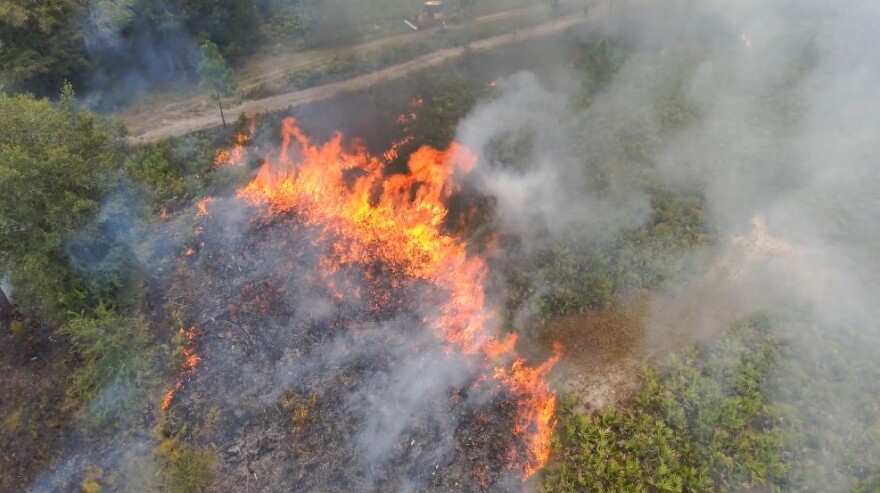The images are seared into our collective memory — wildfires torching California mountain towns as people are unable to escape the leaping flames. And now, the historic Hawaiian town of Lahaina has been reduced to ashes as desperate residents dove into the Pacific to save themselves.
Wildfires are no stranger to Florida. Despite the humidity that hangs over us like a wet blanket, this summer has seen record highs and relatively little rain.
So people like Chris Reed are starting fires to prevent fires.
Reed directs the land management section for the Southwest Florida Water Management District. He directs the flaming spout of a drip torch to some brownish-looking grass and palmettos.
He presses a little lever, and poof goes the grass. And just a bit of the palmetto. As the smoke rises toward the clouds, bits of black ember start to fly around, carried in the breeze. The sooty smell gets everywhere — in your clothes, your hair, and singes your nostrils.
These man-made pyrotechnics mimic the natural cycle of fire. Some native trees — like longleaf pines — require fire for their cone-seeds to germinate. But for decades, that rhythm has been interrupted by people building homes in the woods and by an outdated Smokey the Bear ethos that preached "Only You Can Prevent Forest Fires.

Dry conditions and hot climate fuel the fires
Reed is the anti-Smokey.
"The drip torch is mixed with diesel fuel and gasoline," Reed said. "It has this vent to keep it from back-siphoning into the drip torch, into the fuel itself. And we just light the wick and kind of drip it along to light the wildland fuels."
It's called controlled or prescribed fire. More than 7 million acres burned due to wildfires in the U.S. last year alone — mostly in the arid West. Suppressing natural fire can lead to an accumulation of dead and diseased trees and shrubs that are perfect fuels for major wildfires. And changing climate can aggravate hot and dry conditions that make it more likely a fire will ignite and spread.
So all it takes is one careless person to create a potential disaster.
"Given enough time and a lack of fire, that material builds up over time and essentially it turns into a tinderbox," said Mark Maggard, a senior land manager with the water district. "So all it would take at that point is a lightning strike or a cigarette butt to all of a sudden set off a catastrophic wildfire. If we burn it first, then the likelihood of a wildfire erupting goes down exponentially."

Before a torch is lit, Maggard directs a squad of "burners" clad in heavy yellow fire protection suits. He gathers them together for some pre-burn instructions.
"Once we've got that back-in fire good, we'll start working on our flanks, and ultimately lead to our head fire," Maggard tells them. "So make sure you stay hydrated today, it's supposed to get to 95 degrees. It feels like it's already there. If anything, just call out on the radio, and have a good burn."
Here's what goes into the planning
Maggard says these fires have to be planned months in advance. They look to everything from humidity to chance of rain and lightning to the amount of moisture in the soil. Here at Flatwoods, the direction of the wind is critical, because the park is bounded by three housing developments.
"Before we even light the fire, we have a bulldozer go around," Maggard said. "We've got one on site today and we put in what we call disc lines, which just turns up the dirt, and we have a mineral base around the whole perimeter of the barn. And essentially we use our wind direction to light off a backhand fire first. So we're burning against the wind, so it's a slow steady burn.
"And we develop what we call an area of black — which is burnt fuels. And then we come around both sides and we light off what we call flanks and those kind of go perpendicular to the wind. And then finally we wrap it up with the head fire, which is your hot fire that heats up everything and it burns back into itself, essentially burning itself out."
Maggard says the water district burns 40,000 acres a year in its 16-county area. Each burned area is torched again about every three years.
"We can't rely on wildfires to do their thing anymore because of the advent of people and houses and community here," Maggard said. "So we have to mimic the effects of a wildfire in a controlled setting, and that's where prescribed fire comes into play."
So off his team goes, fire dripping from their torches and smoke rising into the wind. The housing developments on the periphery of the park may smell the smoke, but after this burn, their homes will likely be much safer.





